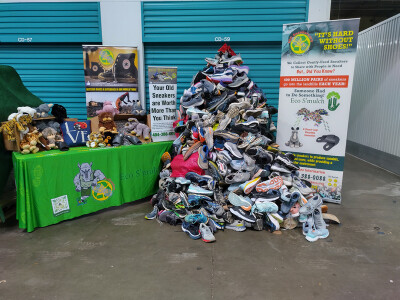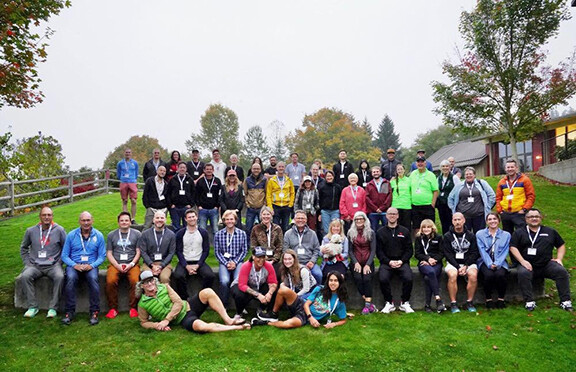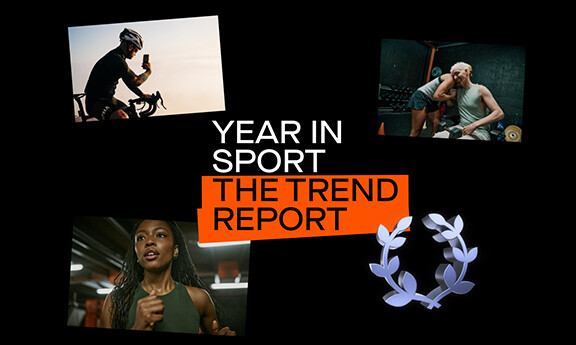Sneaker recycling programs have become common practice in recent years and with more and more sneaker bins popping up at run retailers, it’s become fairly easy for runners to drop off their sneakers without a second thought. Although recycling might seem like a simple practice, the stories behind these recycling programs are far more complex.
So Running Insight reached out to two of the more interesting and successful organizations promoting the concept –Eco Sneakers and Sneaker Impact – who are both actively working to create a better environment for runners and develop programs to help those in need all over the country. Here’s a look at what these two are achieving beyond the recycling bin.
Eco Sneakers: So Mulch More
Eco Sneakers, a Georgia-based 501(c)(3) corporation, was founded on a simple act of kindness. While training for the Peachtree Road Race in Atlanta, founder Bobby Johnson came across a homeless man without shoes and offered him his very own sneakers.
That moment inspired him to launch Eco Sneakers, which provides “used not abused” sneakers to people all over the world. Since its inception, this non-profit has saved and repurposed more than 500,000 pairs of sneakers.
“With growing awareness of climate change, landfill overcrowding and the environment eroding due to pollution, Eco Sneakers also now focuses on sustainability education as well as upcycling unwearable sneakers into Eco S’Mulch, a patented grind made from sneakers,” says Johnson. “The sneaker grind is used as filler for bean bags, seat pillows and stuffed animals. The outside of the ‘stuffies’ is made from plastic bottles.”
The environmental benefits of the Eco S’Mulch are conserving energy, reducing air and water pollution, reducing greenhouse gases and conserving natural resources. With an estimated 600,000 pairs of sneakers ending up in landfills each year, the amount of water wasted is exponential. It takes roughly 2257 gallons of water to make just one pair of shoes.
Since 2015, Eco Sneakers has done all it can to divert textile waste out of the landfills and create new possibilities, but now are requesting more help and encouraging others to get involved.
As for these retailers who are involved, Johnson emphasizes that it is easy to support their local community through participating in the Eco Sneakers program.
“It is easy for retailers to make a difference. There’s no cost — we provide free collection boxes and free shipping,” Johnson points out. The free program offers a way to support community events, races/marathons, and of course, their stores. It’s also a good way to collaborate with track clubs and high school and college running teams.
Making the process simple for retailers also benefits customers who are looking to support businesses reducing their environmental impact. Like many activewear brands that pay close attention to customer concerns, sneaker recycling programs are also aware of customer values and work to help retailers cater to those specific needs.
“Retailers simply collect new, discontinued or ‘used not abused’ running shoes and sneakers, tie them up, lace them together and throw them in the box provided by Eco Sneakers,” he explains. “It’s a good feeling for the customer to know that they are being shoegooders and it’s great for the stores because they can offer discount coupons for the customer to trade-up or replace their current sneakers. Shoe brands can even get involved by choosing us as their sustainability partner,” says Johnson.
Retailers can help this movement by going to ecosneakers.org and making a donation or
calling 404-388-0088 to speak about working together and producing a positive impact
with people and earth.
Making a Sneaker Impact
Like Eco Sneakers, Sneaker Impact, a Miami-based sneaker recycling company, has a mission to keep sneakers out of landfills either by recycling their parts to be used for energy, or by giving them to people in developing countries with a greater need.
Sneaker Impact is a for-profit social enterprise that is reducing waste at home in the U.S. and working with micro-business merchants abroad in developing countries by prolonging the life of sneakers and placing them where they belong — with people in need, not in the landfill.
The group is partnered with several marathons, including Miami, Fort Lauderdale and Los Angeles, and a number of other road races around the country. They also work closely with run clubs, gyms, and universities nationwide to spread the message, according to run community manager Bryan Huberty.
Sneaker Impact is primarily targeting the 87 percent of Americans that don’t recycle.
“Statistics say that 92 percent want to be involved but don’t know how. Our mission is to bring awareness and spread the message about the importance of the sneaker up-cycling movement,” says Huberty.
Sneaker Impact has two programs — one for corporations/retailers and one for consumers. Both are designed to provide a convenient solution for up-cycling, reusing and extending the life of sneakers.
The retail program works by contacting Sneaker Impact and requesting a case of its collection boxes to be placed in stores. These boxes have a professional look and include educational information for customers to serve as conversation starters and to encourage runners to visit the store.
“By placing the box in their store, retailers are giving their customers a location and solution for recycling their sneakers,” explains Huberty. “We make it easy on their staff by tracking how many boxes they have and replenishing when needed. We also count how many sneakers were diverted from landfills by each store.”
Runners and the general public can also participate by requesting a compostable collection mailer bag from Sneaker Impact’s website with pre-paid shipping included. The company ships these bags to residences and each bag can hold up to seven pairs of sneakers. The bags have educational information on them about the importance of being sustainable.
“When the sneakers are received at our headquarters in Miami, they are graded for their condition. The ones that make the cut are shipped to micro-business merchants in developing countries, where they are refurbished/repaired and offered in local markets to give the sneakers a second and third life,” Huberty says.
They currently deal with countries in the Caribbean, Central America, South America, Africa and Asia. The shoes that have no more life are shipped to a waste innovation facility in South Florida, where they are converted into electricity for the local power grid.






